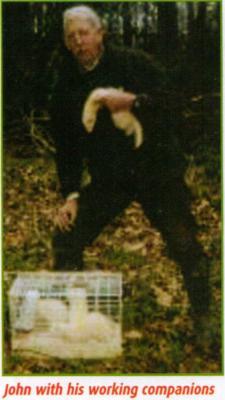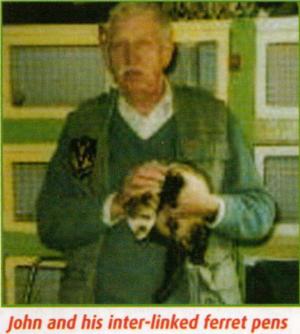Working Ferrets
Worcestershire ferret man JOHN DUGGAN has advice on many aspects of working, including training, care and housing.
Working ferrets have played a major part in my life for more years than I care to remember. I have come to the conclusion that people from all walks of life - all have kept ferrets at some time in their life for catching the odd rabbit or two.
Everyone, of course, has a difference of opinion about the way it should be done. Some like to use hobs, and some jills. Some people use only black polecats or albinos, and so on. We can all learn from one another, with all the different experiences of so many people who live in all parts of the country. With all this shared information, we should be able to get the job done.
One of the main subjects is the housing of ferrets. My own pens are all inter-linked so that ladders connecting each pen make for plenty of exercise and help to keep the animals fit and free from boredom. Putting a small peice of paving slab in front of the trap doors helps to keep claws short.
Maintaining a healthy environment in the living quarters, cleaning out every day and replacing with fresh litter and bedding material is a must. Cleanliness in the ferret pens reduces the possibility of disease. Using an industrial vacuum cleaner with a large diameter suction pipe makes the task easy.
Over the summer months, I get a lot of people visiting my ferret set-up looking for new stock. Sometimes they go away with a young ferret, but only if I consider they are the right people to look after it properly. Most people go away with a lot
 more information about ferrets and how to keep them. I also insist that if anyone cannot keep the ferret for any reason, they return it to me rather than neglect it.
more information about ferrets and how to keep them. I also insist that if anyone cannot keep the ferret for any reason, they return it to me rather than neglect it.
Looking after ferrets, or any other animal, is a full-time job. Keeping them fit and healthy as well as clean takes a lot of time. Working ferrets, I think, need a little extra special attention after going out day after day bolting and catching rabbits and working underground in cold and sometimes wet conditions.
On days out, I take six or eight ferrets at a time so that I can change them over from working to resting as often as possible. Losing good working stock is not on my agenda so, according to the ground conditions and size of the burrow, I use a ferret finder and locating collars. This way you know the area to locate your ferret at all times. People who work ferrets should always include in their tackle a ferret finder and collars.
TRAINING FERRETS TO WORK
Ferret enthusiasts have the good old ferret for many uses. Some people use them for ratting, others for racing. They are also used for carrying cables under buildings. Most of all, the ferret is used for catching and bolting rabbits. Rabbits have always been the farmer's nightmare, digging holes everywhere and eating into the crops. They are a number one pest.
I train my working animals in the garden, going down and around in plastic drainpipe. I play this game with each one daily when they are very young. Training ferrets using this method gives them loads of confidence when the time comes for them to join the working team.
Treating them well, with lots of handling, means they will respond to your kindness, which pays off at the end of the day.
Starting to work young ferrets too early can sometimes be a big mistake. Cornered rabbits can and will kick out damaging a young ferret. I wait until they are six to 12 months old before I use them in the working team. Most of my working animals are well over five years old. My very best working pair are more than ten years old and still enjoy a day's working.
 Hopefully, I will replace some of the older ferrets with last year's youngsters. I always keep records of those bred and trained which enables me to replace any one ot any time and the older stock can enjoy their retirement in a life of luxery.
Hopefully, I will replace some of the older ferrets with last year's youngsters. I always keep records of those bred and trained which enables me to replace any one ot any time and the older stock can enjoy their retirement in a life of luxery.
Enjoying days out in the country, doing my sport and helping to keep the rabbit population at bay, is my favourite pastime but trying to encourage the younger generation to take up the sport seems to be a very hard task indeed, especially in my part of the country.
From time to time a job comes along to move a few rabbits from private gardens. One of these was at the large garden of Madresfield Court, at the foot of the Malvern Hills. Sixty acres, all told, belonging to Lady Morrison. Rabbits were digging holes in the well-manicured lawns and undermining the statues that surround the croquet lawns. This gave me a chance to use my long nets. Surrounding the yew hedge and statues with 200 yards of long net and five of my best working ferrets made the first attempt a success. A friend and myself managed to catch all but one of the rabbits that bolted.
A good job well done. A few more days at the Court are on the cards for the future now that we have established ourselves as regular warreners
